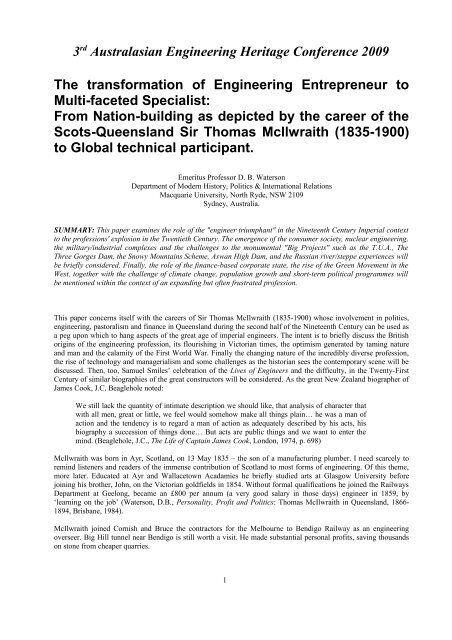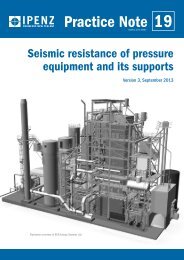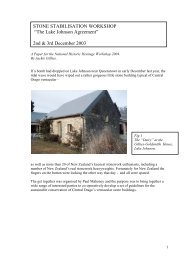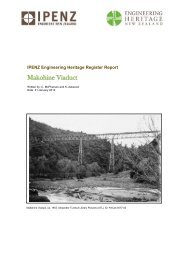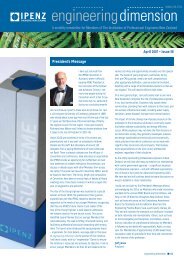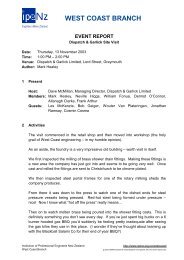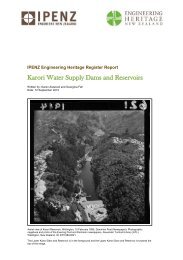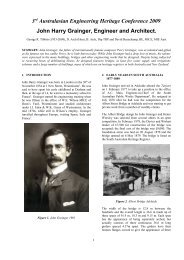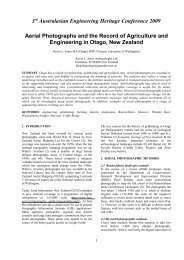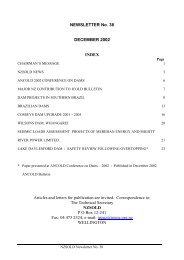The transformation of Engineering Entrepreneur to Multi ... - ipenz
The transformation of Engineering Entrepreneur to Multi ... - ipenz
The transformation of Engineering Entrepreneur to Multi ... - ipenz
Create successful ePaper yourself
Turn your PDF publications into a flip-book with our unique Google optimized e-Paper software.
3 rd Australasian <strong>Engineering</strong> Heritage Conference 2009<br />
<strong>The</strong> <strong>transformation</strong> <strong>of</strong> <strong>Engineering</strong> <strong>Entrepreneur</strong> <strong>to</strong><br />
<strong>Multi</strong>-faceted Specialist:<br />
From Nation-building as depicted by the career <strong>of</strong> the<br />
Scots-Queensland Sir Thomas McIlwraith (1835-1900)<br />
<strong>to</strong> Global technical participant.<br />
Emeritus Pr<strong>of</strong>essor D. B. Waterson<br />
Department <strong>of</strong> Modern His<strong>to</strong>ry, Politics & International Relations<br />
Macquarie University, North Ryde, NSW 2109<br />
Sydney, Australia.<br />
SUMMARY: This paper examines the role <strong>of</strong> the "engineer triumphant" in the Nineteenth Century Imperial context<br />
<strong>to</strong> the pr<strong>of</strong>essions' explosion in the Twentieth Century. <strong>The</strong> emergence <strong>of</strong> the consumer society, nuclear engineering,<br />
the military/industrial complexes and the challenges <strong>to</strong> the monumental "Big Projects" such as the T.U.A., <strong>The</strong><br />
Three Gorges Dam, the Snowy Mountains Scheme, Aswan High Dam, and the Russian river/steppe experiences will<br />
be briefly considered. Finally, the role <strong>of</strong> the finance-based corporate state, the rise <strong>of</strong> the Green Movement in the<br />
West, <strong>to</strong>gether with the challenge <strong>of</strong> climate change, population growth and short-term political programmes will<br />
be mentioned within the context <strong>of</strong> an expanding but <strong>of</strong>ten frustrated pr<strong>of</strong>ession.<br />
This paper concerns itself with the careers <strong>of</strong> Sir Thomas McIlwraith (1835-1900) whose involvement in politics,<br />
engineering, pas<strong>to</strong>ralism and finance in Queensland during the second half <strong>of</strong> the Nineteenth Century can be used as<br />
a peg upon which <strong>to</strong> hang aspects <strong>of</strong> the great age <strong>of</strong> imperial engineers. <strong>The</strong> intent is <strong>to</strong> briefly discuss the British<br />
origins <strong>of</strong> the engineering pr<strong>of</strong>ession, its flourishing in Vic<strong>to</strong>rian times, the optimism generated by taming nature<br />
and man and the calamity <strong>of</strong> the First World War. Finally the changing nature <strong>of</strong> the incredibly diverse pr<strong>of</strong>ession,<br />
the rise <strong>of</strong> technology and managerialism and some challenges as the his<strong>to</strong>rian sees the contemporary scene will be<br />
discussed. <strong>The</strong>n, <strong>to</strong>o, Samuel Smiles’ celebration <strong>of</strong> the Lives <strong>of</strong> Engineers and the difficulty, in the Twenty-First<br />
Century <strong>of</strong> similar biographies <strong>of</strong> the great construc<strong>to</strong>rs will be considered. As the great New Zealand biographer <strong>of</strong><br />
James Cook, J.C. Beaglehole noted:<br />
We still lack the quantity <strong>of</strong> intimate description we should like, that analysis <strong>of</strong> character that<br />
with all men, great or little, we feel would somehow make all things plain… he was a man <strong>of</strong><br />
action and the tendency is <strong>to</strong> regard a man <strong>of</strong> action as adequately described by his acts, his<br />
biography a succession <strong>of</strong> things done… But acts are public things and we want <strong>to</strong> enter the<br />
mind. (Beaglehole, J.C., <strong>The</strong> Life <strong>of</strong> Captain James Cook, London, 1974, p. 698)<br />
McIlwraith was born in Ayr, Scotland, on 13 May 1835 – the son <strong>of</strong> a manufacturing plumber. I need scarcely <strong>to</strong><br />
remind listeners and readers <strong>of</strong> the immense contribution <strong>of</strong> Scotland <strong>to</strong> most forms <strong>of</strong> engineering. Of this theme,<br />
more later. Educated at Ayr and Wallace<strong>to</strong>wn Acadamies he briefly studied arts at Glasgow University before<br />
joining his brother, John, on the Vic<strong>to</strong>rian goldfields in 1854. Without formal qualifications he joined the Railways<br />
Department at Geelong, became an £800 per annum (a very good salary in those days) engineer in 1859, by<br />
‘learning on the job’ (Waterson, D.B., Personality, Pr<strong>of</strong>it and Politics: Thomas McIlwraith in Queensland, 1866-<br />
1894, Brisbane, 1984).<br />
McIlwraith joined Cornish and Bruce the contrac<strong>to</strong>rs for the Melbourne <strong>to</strong> Bendigo Railway as an engineering<br />
overseer. Big Hill tunnel near Bendigo is still worth a visit. He made substantial personal pr<strong>of</strong>its, saving thousands<br />
on s<strong>to</strong>ne from cheaper quarries.<br />
1
McIlwraith moved <strong>to</strong> Queensland in 1864 and invested heavily in Maranoa and northern pas<strong>to</strong>ral and sugar<br />
properties forming the North Australian Pas<strong>to</strong>ral Company, a pioneer example <strong>of</strong> a vertically integrated company<br />
breeding animals, fattening them, killing and freezing them and exporting frozen meat <strong>to</strong> Britain. Here was the<br />
entrepreneur well aware <strong>of</strong> the the engineering and technological breakthroughs that were the foundations <strong>of</strong> the<br />
frozen meat trade. (Waterson, op. cit, pp. 10-13).<br />
Establishing the Darling Downs and Western Land Company, the Queensland Investment and Land Mortgage<br />
Company and the new Queensland National Bank with a mixture <strong>of</strong> British and local capital, McIlwraith was forced<br />
in<strong>to</strong> exile in London, a ruined man lucky <strong>to</strong> avoid gaol for fraud although some fruitful assets had long been<br />
transferred <strong>to</strong> his wife under the Married Women’s Property Act. Gold mining, sugar and copper speculation were,<br />
by the Depression <strong>of</strong> the 1890s, also unsuccessful.<br />
McIlwraith entered colonial politics in 1870, became Minister for Public Works and Mines in 1874 and Premier and<br />
Treasurer in 1878-83. An advocate <strong>of</strong> massive state borrowing for public works, a land-grant Transcontinental<br />
Railway – still talked about – the stimulation <strong>of</strong> large-scale mining and pas<strong>to</strong>ral enterprises and banking and other<br />
financial manipulations. In 1890-93 he was the financial power behind the Griffith-McIlwraith Coalition during the<br />
great-depression, put down the shearing strikes, quarrelled with the Bank <strong>of</strong> England and concealed the parlous state<br />
<strong>of</strong> the Queensland National Bank and his own massive overdraft jointly held with the General Manager, Colonel<br />
Drury.<br />
He flirted with crude Social Darwinism, Queensland nationalism, advocated imperial expansion through engineering<br />
artefacts and single-handedly annexed part <strong>of</strong> New Guinea against the wishes <strong>of</strong> the British Colonial Office.<br />
McIlwraith even managed <strong>to</strong> win the unalloyed approval <strong>of</strong> Francis Adams in his seminal work, <strong>The</strong> Australians: A<br />
Social Sketch, London, 1893, pp. 77-78).<br />
<strong>The</strong>re is another point linking McIlwraith’s notion <strong>of</strong> rational improvement, personal performance and the use <strong>of</strong><br />
engineers <strong>to</strong> alter the world <strong>to</strong> western standards. ‘Andre’ Maurois was aware <strong>of</strong> this aspect <strong>of</strong> the nature <strong>of</strong> British<br />
material colonisation: ‘Aurelle, rather dazed, fuddled with the Indian sun and the scent <strong>of</strong> wild animals, at last<br />
realised that this world is a great park laid out by a gardener god for the gentlemen <strong>of</strong> the United Kingdoms<br />
(Maurois, Andre, <strong>The</strong> Silence <strong>of</strong> Colonel Bramble, Melbourne, 1940, p. 33).<br />
Progress and <strong>transformation</strong>, then, was the goal. But it was <strong>to</strong> be the material program <strong>of</strong> the railway engineer turned<br />
specula<strong>to</strong>r and improving pas<strong>to</strong>ralist. (Waterson, op. cit., pp. 9. 29). He firmly believed in both the imagery and the<br />
transforming power <strong>of</strong> technology and enthusiastically lauded the practical men <strong>of</strong> the world in his 1875 lecture<br />
‘<strong>The</strong> Romance <strong>of</strong> <strong>Engineering</strong>’. Every word <strong>of</strong> Carlyle’s saga <strong>of</strong> steam would have earned McIlwraith’s unstinted<br />
approval:<br />
Of the Poet’s and Prophet’s inspired message and how it makes whole worlds, I shall forbear <strong>to</strong><br />
mention: but cannot the dullest hear steam engines clanking around him? Has he not seen the<br />
Sottish brains – Smith’s idea (and this but a mechanical one) travelling on five wings around<br />
the Cape and across two oceans… at home not only weaving cloth, but rapidly enough<br />
overturning the whole system <strong>of</strong> society… preparing us, by indirect but sure methods,<br />
Industrialism and Government <strong>of</strong> the Wisest (Carlyle, T., Signs <strong>of</strong> the Times, London, 1869,<br />
pp. 317-18)<br />
But there is a dicho<strong>to</strong>my here which Carlyle and later Ruskin acknowledged. Mechanical progress through<br />
engineering triumphs may transform the world but what <strong>of</strong> its effects on human beings, on individual expression and<br />
artistic creativity and passion? Carlyle in his Sar<strong>to</strong>r Resartus was contemptuous <strong>of</strong> ‘Liverpool Steam Carriages’<br />
while Ruskin continued <strong>to</strong> stress ‘Romantic Fairness against a philosophy <strong>of</strong> gain and wealth’ and basically held a<br />
nostalgic feeling for long-dead rural life and held engineering solutions as, by implication, no answers for ones<br />
population and poverty, mass ignorance and disdain for beauty (Ruskin, John, Un<strong>to</strong> This Last: Four Essays in the<br />
First Principles <strong>of</strong> Political Economy, 7 th ed., London, 1890, esp., pp. xi, 156, 167-70).<br />
Here the influence <strong>of</strong> Samuel Smiles (1812-1904) should be mentioned as a widely-read publicist – paralleling<br />
McIlwraith’s 1875 lecture. Like McIlwraith, Smiles was also a Scot and can be canonised as the origina<strong>to</strong>r <strong>of</strong><br />
Business and <strong>Engineering</strong> his<strong>to</strong>ry (Mathew, H.C.G., ‘Samuel Smiles’ in Oxford Dictionary <strong>of</strong> National Biography,<br />
ed. Mathew, H.C.G. and Harrison, B., 50, Oxford, 2004, pp. 1001-4).<br />
2
Smiles was a product <strong>of</strong> the Scot’s Enlightenment like so many <strong>of</strong> his subjects. It was no accident that the University<br />
<strong>of</strong> Glasgow was the first institution in the Empire <strong>to</strong> have a Chair <strong>of</strong> <strong>Engineering</strong> and it is most appropriate that<br />
Dunedin, the most Scottish <strong>of</strong> all Antipodean cities, should host this conference. Smiles stressed the virtues <strong>of</strong> selfhelp,<br />
self improvement through industry and education as well as duty, perseverance and meticulous mathematical<br />
calculation, all qualities which are still part <strong>of</strong> the engineering pr<strong>of</strong>ession (Smiles, Samuel, Lives <strong>of</strong> the Engineers:<br />
<strong>The</strong> Steam Engine, Boul<strong>to</strong>n and Watt, London, 1878, esp., pp. 382-3, 406-09. <strong>The</strong>re are a further four volumes<br />
dealing with canals, lighthouses, roads, locomotives and bridges).<br />
But for McIlwraith, a successful amalgam <strong>of</strong> political fireman and development engineer the fulfilment <strong>of</strong> his<br />
dreams and the continuation <strong>of</strong> his political life depended on Queensland rapidly increasing its population by<br />
immigration and natural increase, massive capital investment from Great Britain, high prices for primary products<br />
and minerals and world economic expansion and stability. But as the depression <strong>of</strong> the 1890s deepened McIlwraith’s<br />
cleverly woven tapestry began <strong>to</strong> unravel. <strong>The</strong>n, <strong>to</strong>o, the human machine began <strong>to</strong> break down. His physical disease,<br />
peripheral neuritis, caused by a Vitamin K deficiency and resulting from viral infections, venereal disease, lead<br />
poisoning from his father and brothers’ lead processing workshops or alcoholism – take your pick – increasingly<br />
influenced his ability <strong>to</strong> deal with a series <strong>of</strong> crises which went far beyond his ability <strong>to</strong> diagnose or control. Great<br />
forces, as Marx observed in the Manifes<strong>to</strong> <strong>of</strong> the Communist Party – just when McIlwraith was moving from<br />
Vic<strong>to</strong>ria <strong>to</strong> New South Wales were in motion. Indeed part <strong>of</strong> the manifes<strong>to</strong> can be read as a hymn <strong>to</strong> the unleashed<br />
powers <strong>of</strong> engineering in the Nineteenth Century but continued in the Twentieth by the Soviet Union, the People’s<br />
Republic <strong>of</strong> China and other States concerned <strong>to</strong> master their environs.<br />
<strong>The</strong> bourgeoisie has created more massive and more productive forces than have all the<br />
preceding generations <strong>to</strong>gether. Subjection <strong>of</strong> Nature’s forces <strong>to</strong> man, machinery, application<br />
<strong>of</strong> chemistry <strong>to</strong> industry and agriculture, steam navigation, railway, electric telegraphs, clearing<br />
whole continents for cultivation, canalisation <strong>of</strong> rivers, whole populations conjured up out <strong>of</strong><br />
the ground – what earlier century had even a presentiment that such productive forces<br />
slumbered in the lap <strong>of</strong> social labour? (Marx, K., and Engels, F., <strong>The</strong> Communist Manifes<strong>to</strong>,<br />
London, 1847, new ed., Moscow, n.d., pp. 50-51).<br />
<strong>Engineering</strong> was thus essential, throughout the world, including the colonial areas as Michael Adas has shown, <strong>of</strong><br />
the creation not only <strong>of</strong> new societies <strong>of</strong> settlement but a variety <strong>of</strong> interlocking and interacting frontiers, the first<br />
wave <strong>of</strong> which we can now see as the deepening hurricane <strong>of</strong> globalisation (Adas, M., Machines as the Measure <strong>of</strong><br />
Men: Science, Technology and Western Dominance, Ithaca, 1989, esp., 184-97, 220-240, 357-385).<br />
I do not intend <strong>to</strong> analyse McIlwraith’s political skills and superficial reasons for his eventual downfall just noting<br />
that his name, unlike that <strong>of</strong> Alan Bond, is not attached <strong>to</strong> a university or even a business school, but only an<br />
obscure mountain range in North Queensland, a scattering <strong>of</strong> street names, a couple <strong>of</strong> portraits hidden away in<br />
libraries and, more significantly, engineering scholarships at Queensland University. Even his grave is situated close<br />
<strong>to</strong> his birthplace at Ayr and near a row <strong>of</strong> Empire airmen’s graves, the victims <strong>of</strong> training accidents at Turnberry<br />
airfield, a few miles away. <strong>The</strong>ir deaths were, it has been remarked, a consequence <strong>of</strong> the planet’s first industrial<br />
World War which, as we shall see, was essentially a murderous engineers conflict – although few military leaders<br />
recognised this at the time.<br />
McIlwraith may have been a polymath but throughout – the exploding frontier <strong>of</strong> Western penetration and<br />
exploitation engineers were at the forefront <strong>of</strong> the advance. Henry Lawson, when commenting on the failure <strong>of</strong> the<br />
shearer’s strikes that, by moving men, arms and materials, the state had crushed, remarked: ‘through railways now<br />
the mighty bush is tethered <strong>to</strong> the world’. Lawson went further in 1904 with his nationalist plea for the creation, not<br />
<strong>of</strong> noble shearers and bush denizens <strong>of</strong> Russel Ward’s Australian Legend and Bean’s Anzac celebration <strong>of</strong> outback<br />
blood and soil virtues, but the metropolitan Australian engineer. <strong>The</strong> verse is worth quoting in full:<br />
3
AUSTRALIAN ENGINEERS<br />
Ah, well! but the case seems hopeless, and the pen might write in vain;<br />
<strong>The</strong> people gabble <strong>of</strong> old things over and over again.<br />
For the sake <strong>of</strong> the sleek importer we slave with the pick and the shears,<br />
While hundreds <strong>of</strong> boys in Australia long <strong>to</strong> be engineers.<br />
A new generation has risen under Australian skies,<br />
Boys with the light <strong>of</strong> genius deep in their dreamy eyes––<br />
Not as <strong>of</strong> artists or poets with their vain imaginings,<br />
But born <strong>to</strong> be thinkers and doers, and makers <strong>of</strong> wonderful things.<br />
Born <strong>to</strong> be builders <strong>of</strong> vessels in the Harbours <strong>of</strong> Waste and Loss,<br />
That shall carry our goods <strong>to</strong> the nations, flying the Southern Cross;<br />
And fleets that shall guard our seaboard – while the East is backed by the Jews––<br />
Under Australian captains, and manned by Australian crews.<br />
Boys who are slight and quiet, but boys who are strong and true,<br />
Dreaming <strong>of</strong> great inventions – always <strong>of</strong> something new;<br />
With brains untrammelled by training, but quick where reason directs––<br />
Boys with imagination and keen, strong intellects.<br />
<strong>The</strong>y long for the crank and the belting, the gear and the whirring wheel,<br />
<strong>The</strong> stamp <strong>of</strong> the giant hammer, the glint <strong>of</strong> the polished steel,<br />
For the mould, and the vice, and the turning-lathe – they are boys who long for the keys<br />
To the doors <strong>of</strong> the world's mechanics and science's mysteries.<br />
<strong>The</strong>y would be makers <strong>of</strong> fabrics, <strong>of</strong> cloth for the continents––<br />
Makers <strong>of</strong> mighty engines and delicate instruments;<br />
It is they who would set fair cities on the western plains far out,<br />
<strong>The</strong>y who would garden the deserts––it is they who would conquer the drought!<br />
<strong>The</strong>y see the dykes <strong>to</strong> the skyline, where a dust-waste blazes <strong>to</strong>-day,<br />
And they hear the lap <strong>of</strong> the waters on the miles <strong>of</strong> sand and clay;<br />
<strong>The</strong>y see the rainfall increasing, and the bountiful sweeps <strong>of</strong> grass,<br />
And all the year on the rivers long strings <strong>of</strong> their barges pass.<br />
But still are the steamers loading with our timber and wood and gold,<br />
To return with the costly shoddy stacked high in the foreign hold;<br />
With cardboard boots for our leather, and Brum-magem goods and slops<br />
For thin, white-faced Australians <strong>to</strong> sell in our sordid shops.<br />
(Henry Lawson, Collected Verse, edited by Colin Roderick, Volume Two, Sydney, 1968, pp.<br />
92-93).<br />
Ironically, a decade later it was an Australian engineer <strong>of</strong> Jewish birth, Sir John Monash who led the First AIF <strong>to</strong> its<br />
great vic<strong>to</strong>ries and who successfully combined logistics, airpower, tanks and other industrial material in a unique<br />
and devastating fashion (Serle, G.S., John Monash, Melbourne, 1982).<br />
His contemporary Herbert Hoover, an American mining engineer with a stint on the West Australian goldfields and<br />
a brilliant organiser <strong>of</strong> relief after the First World War, could not adapt his skills <strong>to</strong> overcoming the worst effects <strong>of</strong><br />
the Great Depression in the United States. While this President is remembered largely for his omissions and the<br />
construction <strong>of</strong> the Boulder (later Hoover) Dam on Colorado River, his successor F.D. Roosevelt paradoxically used<br />
the talents <strong>of</strong> the engineers on the great Tennessee Valley Authority’s schemes and other massive construction feats.<br />
To race ahead it was the Corps <strong>of</strong> Engineers under General Leslie Groves that provided the infrastructure that<br />
produced the a<strong>to</strong>mic bomb while the TVA and New Deal provided much <strong>of</strong> the conceptual influences behind the<br />
Snowy Mountains power and irrigation undertaking, itself Australia’s largest and most important Twentieth Century<br />
engineering feat, presided over by a son <strong>of</strong> a nation that has produced far more engineers than its population might<br />
have been expected <strong>to</strong> germinate, Sir William Hudson.<br />
4
But I digress. <strong>The</strong> au<strong>to</strong>biography <strong>of</strong> the Dublin-born railway engineer C.O. Burge whose efforts as a servant <strong>of</strong> the<br />
British Empire spanned five continents. His creed came straight from the British Institution <strong>of</strong> Civil Engineers: ‘<strong>The</strong><br />
art <strong>of</strong> directing the great sources <strong>of</strong> power in nature for the use and convenience <strong>of</strong> man, as the means <strong>of</strong> production<br />
and <strong>of</strong> traffic in states both the external and internal trade’ (Burge, C.O., <strong>The</strong> Adventures <strong>of</strong> a Civil Engineer: Fifty<br />
Years on Five Continents, London, 1909, p. 37).<br />
Burge believed with Smiles and McIlwraith that ‘<strong>to</strong> the engineer we owe much <strong>to</strong> the moral and intellectual progress<br />
<strong>of</strong> mankind’ (Ibid., p. 38). Working on the great period <strong>of</strong> Indian Railway construction which, with the English<br />
language and a form <strong>of</strong> social democracy was the Raj’s contribution <strong>to</strong> India, Burge also worked on bridges, Cape <strong>of</strong><br />
Good Hope railways and, closer <strong>to</strong> home, what was until the Sydney Harbour Bridge’s construction (1932) the<br />
largest project in New South Wales, the Hawkesbury River Bridge (1889). As Resident Engineer he and the<br />
American contrac<strong>to</strong>rs employed techniques unrivalled for boldness, innovation and effectiveness. Indeed, the seven<br />
piers carrying the structure are still in existence long after the bridge itself was replaced. After the bridge was<br />
completed Burge supervised the removal <strong>of</strong> the Devonshire Street Cemetery’s inhabitants who, in the interests <strong>of</strong><br />
progress, made way for the new Sydney Central Railway Station (Ibid., pp. 256-62).<br />
As an interesting sidelight Burge observed that many engineers were also Freemasons. <strong>The</strong> connection <strong>of</strong> both crafts<br />
<strong>to</strong> ‘the great Architect <strong>of</strong> the Universe’ is clear. Burge was part <strong>of</strong> Buchanan’s ‘motley crew’ <strong>of</strong> artisans, practical<br />
craftsmen who were mainly <strong>of</strong> a conservative political bent although, in contradiction <strong>to</strong> Ruskin, were <strong>of</strong>ten <strong>of</strong> a<br />
artistic bent with an ability <strong>to</strong> see inventions and their implementation in the mind’s eye (Buchanan, R.A.,<br />
‘Gentlemen Engineers: <strong>The</strong> Making <strong>of</strong> a Pr<strong>of</strong>ession’, Vic<strong>to</strong>rian Studies, 26, 1983, pp. 410-11. I am indebted <strong>to</strong><br />
Pr<strong>of</strong>essor Caroll Purcell for these and other observations. Purcell, C., White Heat, People and Technology, Berkeley,<br />
1994, pp. 47-48).<br />
But even before the disastrous Great War the day <strong>of</strong> the independent innovative engineer was almost over as a<br />
dependence on mathematical formulae and computer models manipulated by a variety <strong>of</strong> well-trained experts<br />
provided ‘information rather than insight, and labour marshalled by scientific management’ (Purcell, op. cit., pp. 47-<br />
48). To these developments I would add the demands <strong>of</strong> corporate and finance capital on politics, both social<br />
democratic and authoritarian and the growth <strong>of</strong> a consumer and rapid replacement society let alone the complexities<br />
<strong>of</strong> an inven<strong>to</strong>r/ engineer increasingly at the disposal <strong>of</strong> a military-industrial complex (Ferguson, E., ‘How Engineers<br />
Have Lost Touch’, American Heritage and Technology, 8, 1993, pp. 16-20).<br />
From the beginning <strong>of</strong> the Twentieth Century as power shifted from Western Europe <strong>to</strong> the United States engineers<br />
were employed by large corporations such as General Electric, Ford, General Mo<strong>to</strong>rs and United States Steel. <strong>The</strong><br />
Europeans as craftsmen/ engineers were still capable <strong>of</strong> great innovations as radar, penicillin, computers, a<strong>to</strong>mic<br />
physics and jet propulsion demonstrated but mass-manufacture was <strong>of</strong>ten transferred <strong>to</strong> the United States and then <strong>to</strong><br />
Japan and now South Korea, China and India.<br />
If as Purcell claims, the mechanic/ inven<strong>to</strong>r Henry Ford and Frederick Winslow Taylor, a consulting engineer were<br />
‘the midwives <strong>of</strong> the Twentieth Century… it was a mass project based on the principles <strong>of</strong> power, accuracy,<br />
economy, speed and recognition’. <strong>The</strong>se are qualities which all engineers both old and new recognise, but which can<br />
be dis<strong>to</strong>rted by society’s obsession with a mechanical mastery over both nature and other human beings. A useful<br />
corrective <strong>to</strong> this is the screening <strong>of</strong> Fritz Lang’s 1927 epic Metropolis or the rapid acceleration in<strong>to</strong> reality <strong>of</strong><br />
Aldous Huxley’s Brave New World and the discovery and engineering <strong>of</strong> the human genome (Purcell, op. cit., pp.<br />
94-7). But increasingly engineering’s role in the provision and distribution <strong>of</strong> clean water through sewers, dams,<br />
recycling and harvesting techniques will become even more important in the 21 st Century as pressure on existing<br />
supplies and the effects <strong>of</strong> climate change become more apparent. C.Y. O’Connor’s Western Australian Goldfields<br />
pipeline and Maurice O’Shaughnessy’s Sierra Nevada-San Francisco water supply are perhaps, like Watt and<br />
Stephenson's Steam engines <strong>of</strong> the previous century, harbingers <strong>of</strong> a new age celebrated not only in the United<br />
States but in Lenin’s Soviet Union symbolised by the giant Dnepropetrovsk Dam on the Dnieper. It is no accident<br />
that the engineer, unlike army <strong>of</strong>ficers, intellectuals and party ikons remained virtually un<strong>to</strong>uched by the purges <strong>of</strong><br />
the Stalin years (see: Sinclair, B., ‘<strong>The</strong> Pr<strong>of</strong>ession <strong>of</strong> Engineers in America’, in Purcell, C., A Companion <strong>to</strong><br />
American Technology, Oxford, 2005, pp. 363-384).<br />
5
I conclude with some observations on the long journey <strong>of</strong> the engineering fraternity from Watt <strong>to</strong> entrepreneurs such<br />
as McIlwraith, <strong>to</strong> the corporate team player and now a member <strong>of</strong> a pr<strong>of</strong>ession which includes most, if not all facets<br />
<strong>of</strong> our daily life from bio-mechanics <strong>to</strong> aircraft, from engines <strong>to</strong> a<strong>to</strong>m and from computers <strong>to</strong> communications. <strong>The</strong><br />
challenges facing the pr<strong>of</strong>ession have been well summed up by Rosalind Williams:<br />
<strong>The</strong>ir time (little e-engineering) is past and will not come again… but it has left a legacy that<br />
provides a solid foundation for the future; confidence in the ability <strong>to</strong> solve problems, energy<br />
and hard work; the habit <strong>of</strong> teamwork… the delicate balance between investment in and<br />
chitance from capitalism; the belief in community and progress; the assumption <strong>of</strong><br />
responsibility for the material world.<br />
We are not confronting the death <strong>of</strong> engineering any more than we confront the death <strong>of</strong> nature,<br />
his<strong>to</strong>ry or science… But it will be especially painful <strong>to</strong> make the transition from acting in a<br />
familiar mould… <strong>to</strong> acting in the larger and more disorderly world (Williams, R., A His<strong>to</strong>rian<br />
Confronts Technological Change, Cambridge, Mass., 2003, pp. 87-88).<br />
Whether or not the eighteen engineer-trained members <strong>of</strong> the twenty-five strong Chinese Politburo and the new<br />
Japanese Prime Minister also a graduate engineer will make a difference remains <strong>to</strong> be seen (Encyclopedia<br />
Britanica Yearbook, 2013, p. 415). But I started with a Scot and will finish with a note <strong>of</strong> cheer <strong>to</strong> all engineers.<br />
Lord Brougham’s epitaph <strong>to</strong> Watt on the colossal monument <strong>to</strong> the genius in Westminster Abbey is still worth<br />
quoting:<br />
(Smiles, S. op. cit., p. 404)<br />
D.B. Waterson.<br />
Not <strong>to</strong> perpetuate a Name<br />
Which must endure while the Peaceful Arts flourish,<br />
But <strong>to</strong> show<br />
That Mankind have learned <strong>to</strong> honour those<br />
Who best deserve their gratitude,<br />
<strong>The</strong> King,<br />
His Ministers, and many <strong>of</strong> the Nobles<br />
And Commoners <strong>of</strong> the Realm,<br />
Raised this Monument <strong>to</strong><br />
JAMES WATT,<br />
Who directing the Force <strong>of</strong> an original Genius<br />
Early exercised in Philosophic Research<br />
To the Improvement <strong>of</strong><br />
<strong>The</strong> Steam Engine,<br />
Enlarged the Resources <strong>of</strong> his Country,<br />
Increased the Power <strong>of</strong> Man,<br />
And rose <strong>to</strong> an Eminent Place<br />
Among the most illustrious Followers <strong>of</strong> Science,<br />
And the real Benefac<strong>to</strong>rs <strong>of</strong> the World.<br />
Born at Greenock, 1736.<br />
Dies at Heathfield, in Staffordshire, 1819.<br />
6


